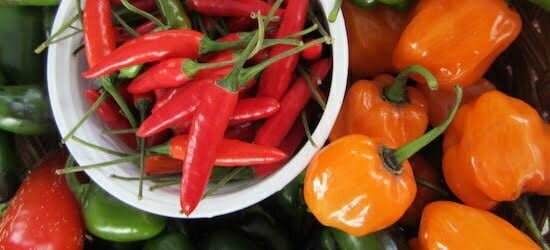Late summer and early autumn produce continues to mingle on farmers tailgate market tables, giving shoppers a panoply of options. You can get ripe tomatoes, sweet and hot peppers, eggplant, okra, beans, and potatoes alongside winter squash, apples, the earliest sweet potatoes, and hardy greens like kale, collards, arugula, chard, and mustard. With this abundance, you might be thinking about preserving a little bit for later. Not sure where to start? DIY hot sauce is one of the easiest ways to savor local flavor all winter.
Making your own shelf-stable hot sauce can be as simple as blending your favorite hot peppers with vinegar, salt, and maybe a hint of sweetener, then cooking the puree for about 15 minutes. Start with a ratio of about one pound of peppers to a half a cup of vinegar and half a tablespoon of salt, and increase vinegar and salt to taste. Cool the puree and divide into bottles, or strain first for a thinner sauce.
You can also ferment peppers for hot sauce, which takes a bit more time but is just as simple. Fermentation offers a deeper, more complex flavor. Remove stems and halve or rough chop one pound of peppers. Place in a clean mason jar or crock, leaving one inch of head space. Make a brine by mixing three tablespoons of salt with one quart of warm, unchlorinated water. (Chlorinated water may hinder the fermentation process, so use filtered water or let your water sit overnight to dechlorinate.) Pour the brine over the peppers, pressing down to remove any air bubbles. Use a weight to keep peppers completely submerged in the brine. Screw on the lid and set out of direct sunlight for one to two weeks. You will need to “burp” the jars by unscrewing the lid slightly to let out gases every few days. Once your fermentation starts to taste slightly sour, you’re ready—or you can keep fermenting for longer! Strain the peppers, reserving the brine, and blend with about a half a cup to a cup of brine. You can also replace some of the brine with vinegar, if desired. As with non-fermented sauce, you can strain your hot sauce or use the thicker puree.
No matter which method you choose, you have lots of options for experimentation. Thin-walled peppers, like habaneros, result in a looser sauce, while thick-walled peppers, like jalapenos, have a higher pectin content and will be thicker. Looking for a milder sauce? Combine one or two hot peppers with bell or other sweet peppers. Add in spices, like cumin, cinnamon, or coriander, or aromatic veggies like onion, garlic, or carrots. You can also include berries or other fruits—the natural sugars will aid in the fermentation process.
Farmers have a wide variety of peppers available and you can make sauce with any type or combination. A few to look out for: chimayo peppers, available from Sleight Family Farm at North Asheville Tailgate Market, have medium heat and a sweet and smoky flavor; Ten Mile Farm, at ASAP and Black Mountain markets, has cherry bomb peppers, which are piquant with thick flesh; for a mild sauce, get a heatless habanero variety from Flying Cloud Farm at North Asheville and River Arts District markets; and for extreme heat, look for bird’s eye chilies from Lee’s One Fortune Farm, at ASAP, Black Mountain, West Asheville, River Arts District, and East Asheville markets.
At farmers markets now you’ll also farm-fresh eggs, cheese, bread, pastries, drinks, and prepared foods. There are more than 100 farmers tailgate markets throughout the Appalachian Grown region. Find them, as well as farms and other local food businesses, in ASAP’s online Local Food Guide at appalachiangrown.org. ASAP’s online Local Food Guide.
Fresh at Farmers Markets This Week

